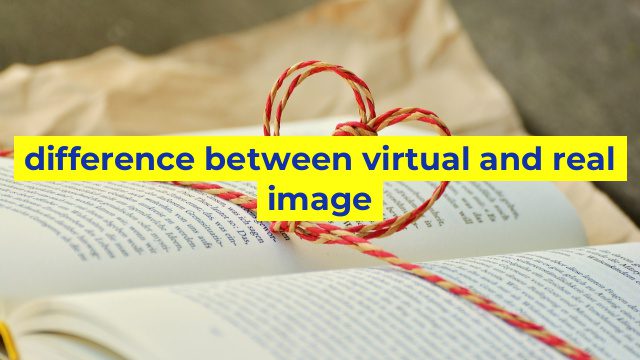Understanding the Difference Between Virtual and Real Images
Introduction
When it comes to the world of optics and imaging, there are two terms that we often come across, virtual and real images. While they may sound similar, they are quite different from each other. In this article, we’ll explore what these terms mean and how they differ from one another.
What is a Virtual Image?
A virtual image is an image that appears to be where it isn’t. This is because a virtual image is formed when light rays appear to diverge from a particular point after passing through a lens or mirror. Virtual images are always seen through the lens or mirror, and they always appear upright. However, they are never projected onto a screen.
An example of a virtual image can be seen with a magnifying glass, where the image of an object appears to be enlarged and located behind the magnifying lens.
What is a Real Image?
On the other hand, a real image is an image that appears where it is supposed to be. This is because a real image is formed when light rays converge at a particular point after passing through a lens or mirror. Unlike virtual images, real images can be projected onto a screen, and they always appear inverted.
A typical example of a real image can be seen in a movie theatre, where images are projected onto a screen at the front of the theater.
Key Differences Between Virtual and Real Images
Now that we have a basic understanding of what virtual and real images are, let’s take a closer look at the key differences between these two types of images:
– A virtual image appears to be where it isn’t, while a real image appears where it is supposed to be.
– A virtual image is always upright, while a real image is always inverted.
– A virtual image cannot be projected onto a screen, while a real image can.
– A virtual image is formed when light rays appear to diverge from a point, while a real image is formed when light rays converge at a point.
Conclusion
In conclusion, while virtual and real images may sound similar, they differ in significant ways. Understanding the difference between the two types of images is crucial in optics and imaging, and it can help you better appreciate the workings of cameras, telescopes, and microscopes. Whether you’re a student of physics, photography, or just have a general interest in science, knowing how virtual and real images work is an essential part of learning about the world around us.
Table difference between virtual and real image
| Virtual Image | Real Image |
|---|---|
| A virtual image is formed when light rays don’t actually meet at the image location. | A real image is formed when light rays actually converge and meet at the image location. |
| A virtual image can’t be projected onto a screen. | A real image can be projected onto a screen. |
| A virtual image is always upright. | A real image can be either upright or inverted. |
| A virtual image is always located on the opposite side of the mirror or lens as the object. | A real image can be located on either the same side or opposite side of the mirror or lens as the object. |
| Examples of virtual images are the images formed by a plane mirror or by a diverging lens. | Examples of real images are the images formed by a converging lens or a concave mirror. |
